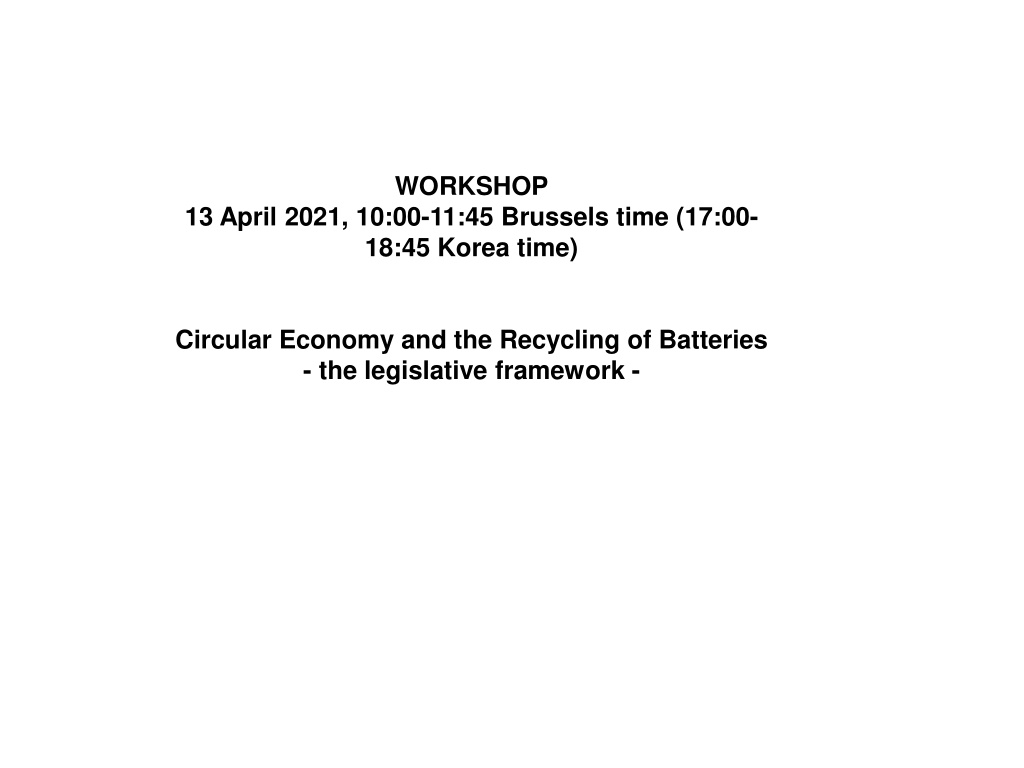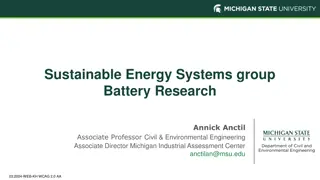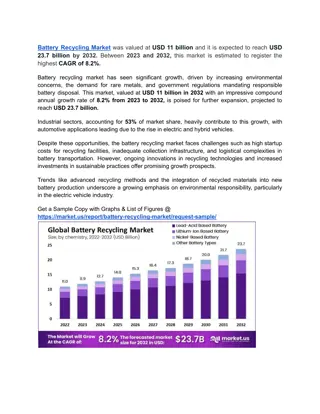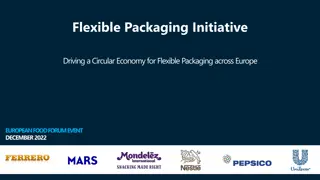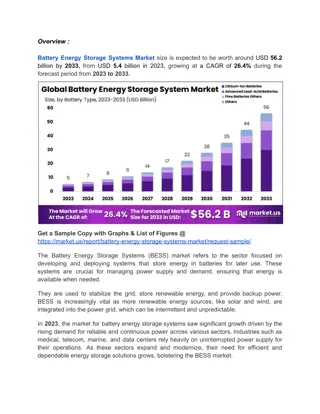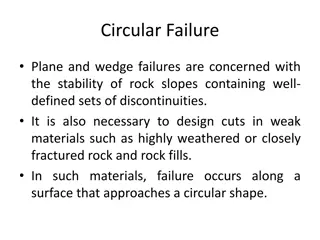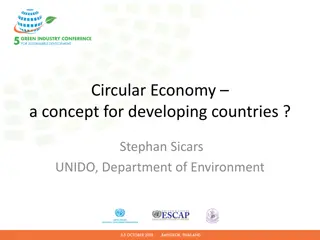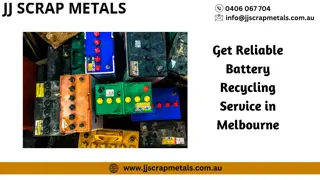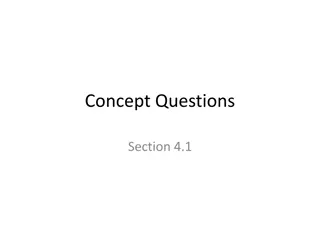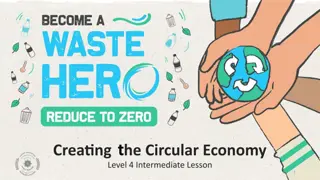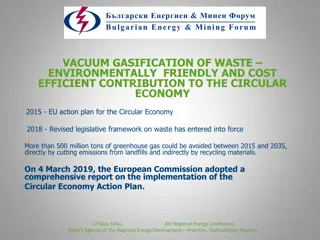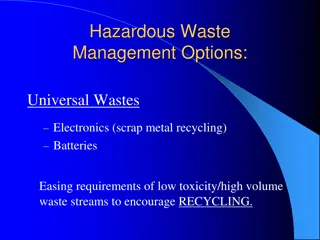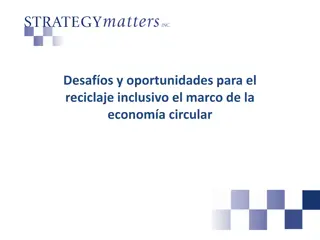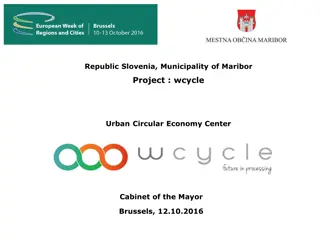Understanding the Legislative Framework for Battery Recycling in Circular Economy
This workshop on Circular Economy and Battery Recycling discusses the legislative framework in the EU surrounding waste batteries. Key points include extended producer responsibility, prohibition of certain batteries with hazardous substances, and requirements for safe removal and recycling processes. The directive aims to promote high collection and recycling rates while reducing environmental impact.
- Circular Economy
- Battery Recycling
- EU Legislation
- Extended Producer Responsibility
- Environmental Impact
Download Presentation

Please find below an Image/Link to download the presentation.
The content on the website is provided AS IS for your information and personal use only. It may not be sold, licensed, or shared on other websites without obtaining consent from the author. Download presentation by click this link. If you encounter any issues during the download, it is possible that the publisher has removed the file from their server.
E N D
Presentation Transcript
WORKSHOP 13 April 2021, 10:00-11:45 Brussels time (17:00- 18:45 Korea time) Circular Economy and the Recycling of Batteries - the legislative framework -
AGENDA Short review on the EU policy on WBA Circular Economy Extended producer responsibility Proposal for a Regulament
Legislative Set-Up Directive 2006/66/EC on batteries and accumulators and waste batteries, as amended Commission Decision 2008/763/EC establishing a common methodology for the calculation of annual sales of portable batteries and accumulators to end-users; Commission Decision 2009/851/EC establishing a questionnaire for Member States reports on the implementation; Commission Regulation (EU) No 1103/2010 establishing rules as regards capacity labelling of portable secondary (rechargeable) and automotive batteries and accumulators; Commission Regulation (EU) No 493/2012 laying down detailed rules regarding the calculation of recycling efficiencies of the recycling processes of waste batteries and accumulators. Directive 2008/98/EC on waste and repealing certain Directives, as amended Article 8 Extended producer responsibility & 8a General minimum requirements for extended producer responsibility schemes; Annex IVa examples of economic instruments and other measures to provide incentives for the application of the waste hierarchy
The aim of the Directive It prohibits the placing on the market of certain batteries (or accumulators) with a mercury or cadmium content above a fixed threshold. It promotes a high rate of collection and recycling of waste batteries and improvement in the environmental performance of all involved in the life-cycle of batteries, including their recycling and disposal. The aim is to cut the amount of hazardous substances in particular, mercury, cadmium and lead dumped in the environment; this should be done by reducing the use of these substances in batteries and by treating and re-using the amounts that are used.
Key points It must be possible to remove batteries readily and safely. Thus, appliances incorporating batteries must be accompanied by instructions on how these can be safely removed by either the end-user or by independent qualified professionals. EU countries also have to ensure that batteries that have been collected are treated and recycled using best available techniques. Energy recovery is not considered a recycling process. As a minimum, treatment must include removal of all fluids and acids. Batteries must be treated and stored (even if only temporarily) in sites with impermeable surfaces and weatherproof covering, or in suitable containers. The directive also establishes obligations in relation to the efficiencies of the recycling processes to which batteries are subject to, depending on their chemical composition.
Key points Producers (or third parties acting on their behalf) must bear the net cost of collecting, treating and recycling industrial, automotive and portable batteries. Producers of portable batteries must finance the cost arising from public information campaigns on the collection, treatment and recycling of all waste portable batteries. Small producers may be exempted from this obligation if this does not impede the proper functioning of the collection and recycling schemes. All producers of batteries must be registered. MS shall create the conditions for a national register body (state or private owned)
AGENDA Short review on the EU policy on WBA Circular Economy Extended producer responsibility New regulation for WBA
Circular economy The European Green Deal is the Union plan to make the EU's economy sustainable. This can be done by turning climate and environmental challenges into opportunities and making the transition just and inclusive for all. The European Green Deal provides an action plan to boost the efficient use of resources by moving to a clean, circular economy restore biodiversity and cut pollution In 2015, the European Commission adopted an ambitious Circular Economy Action Plan, which includes measures that will help stimulate Europe's transition towards a circular economy, boost global competitiveness, foster sustainable economic growth and generate new jobs.
Circular economy The EU Action Plan for the Circular Economy establishes a concrete and ambitious programme of action, with measures covering the whole cycle: from production and consumption to waste management and the market for secondary raw materials and a revised legislative proposal on waste. The Action Plan introduces legislative and non-legislative measures targeting areas where action at the EU level brings real added value Implementation of the first Circular Economy Action Plan: The revised legislative framework on waste has entered into force in July 2018. It sets clear targets for reduction of waste and establish an ambitious and credible long-term path for waste management and recycling.
Circular economy One of the key elements of the Circular Economy Package was the introduction of minimum requirements for the extended producer responsibility schemes to improve their governance and cost efficiency (Directive 2018/851/CE ). The Article 8a of the Directive 2018/851/CE imposes minimum obligations for EPR systems from all the other directives: Article 8a(4)(c) on necessary costs, Article 8a(4)(b) on fee modulation Article 8a(1)(d) on equal treatment, Article 8a(5) on monitoring and enforcement of EPR obligations, including in the case of distance sales Study to support preparation of the Commissions Guidance for EPR Schemes (April 2020)
Circular economy Article 8a of WFD 2018/851 Producers/PROs: have a clearly defined geographical, product and material coverage provide an appropriate availability of waste collection system have the financial/financial and organizational means to meet their responsibility The financial contributions paid by producers: cover the net costs of separate collection of waste, transport and treatment cover the costs of providing adequate information to waste holders cover the costs of data gathering and reporting do not exceed the costs that are necessary to provide waste management services in a cost-efficient way Adequate self-control mechanism supported by regular independent audits In case of multiple PROs, at least one independent body or a public authority to oversee the implementation of EPR obligations Regular dialogue between relevant stakeholders involved in the implementation of EPR scheme Publicly available information
AGENDA Short review on the EU policy on WBA Circular Economy Extended producer responsibility New regulation for WBA
General functions of PROs/EPR Organise, often together with the local authorities, the take back of post- consumer products. Ensure recovery and recycling targets compliance. Assist companies in (packaging) waste prevention, eco-design promotion & communication materials towards the waste holder, together with the local authorities. Verify the data and reporting of those companies. Report to national authorities. Source: EXPRA (2016)
Competition There are three types of competition in EPR schemes: competition among waste treatment operators, competition on the infrastructure and competition among PROs. Each completion needs to be regulated with a clear rules sets.
Established EPR across the Union At EU level, three Directives introduce EPR as a policy approach: the ELV Directive 2000/53/EC, the WEEE Directive 2012/19/EU and the Batteries Directive 2006/66/EC. EPR is also widely used in support of the implementation of the Packaging and Packaging Waste Directive (94/62/EC), although the Directive itself does not impose the principle. It must however be reminded that, beyond these types of waste, in some countries, Extended Producer Responsibility schemes can cover additional products, notably: used oils, used tyres, graphic paper and textile, as well as many other kind of products such as: medicines, fluorinated refrigerant fluids, agricultural films, mobile homes, furniture, etc.
Different concepts depending on battery classification Economic relations between producers/ importers, users and collectors/ recyclers depend on the categories as established by the Batteries Directive: For portable batteries, the producers have established producer responsibility organisations (PROs) in all Member States to organise the EPR obligations, including collection, safe storage, transport and recycling of relevant batteries. The level of fees paid by the producers differs across the EU. Competing PROs have no benefits when exceeding the targets for collection. Consequently, PROs might compete (in the best case) to exactly meet not less and not more the required collection rate. In worse cases, PROs might compete by selecting profitable batteries, making use of battery collection of other than from private consumers or even trading collection and recycling volumes, only without any operative activity
Different concepts for EPRs depending on battery classification Regarding industrial batteries, the user is responsible for handling spent batteries and the producer is obliged to not refuse to take back waste industrial batteries . This renders the end user responsible for safe collection, storage and transport of spent industrial batteries to the producer (or more likely to recycling sites). Private persons are becoming more and more relevant as consumers of industrial batteries. However, the Batteries Directive does not establish requirements for EPR obligations for collecting such industrial batteries like batteries for e-bikes, electric cars or power storage for photovoltaic power. According to the Batteries Directive, the private consumer is responsible for caring for safe collection, storage and transport of spent industrial batteries to the producer (or more likely to recycling sites).
Different concepts for EPRs depending on battery classification For automotive SLI batteries, which are nearly entirely dominated by lead-acid batteries, the value chain for recycling is apparently profitable and prohibitions to dispose of lead-acid batteries are implemented by the Member States. The conditions for collection (schemes) are different across the Member States. Risks remain in relation to volatile prices that might jeopardise the economic viability for recyclers and in relation to far distances to collection points and little revenues for the last owner for a single spent lead-acid battery, which might also cause losses of spent batteries, and in consequence possibly illegal disposal.
AGENDA Short review on the EU policy on WBA Circular Economy Extended producer responsibility New regulation for WBA
Future. On 10 November 2020, the Commission adopted the first Action Plan s milestone: new legislation on batteries in support of the Strategic Action Plan on Batteries and the circular economy The aim is that batteries placed on the EU market are sustainable, circular, high-performing and safe all along their entire life cycle, that they are collected, repurposed and recycled, becoming a true source of valuable raw materials.
Proposal for a NEW Regulation concerning batteries and waste batteries, repealing Directive 2006/66/EC The existing EU Batteries Directive dates to 2006 and is no longer up- to-date. New socio-economic conditions, technological developments, markets, and battery uses have emerged and the environmental challenges they pose have to be met with a new ambitions. Global demand for batteries is set to increase 14 fold by 2030 and the EU could account for 17% of that demand, and a strong response for electric vehicles batteries Why a regulation instead of a Directive? In order to have a significant impact on the EU battery market, these measures are legally binding and adopted at EU level.
What are the main areas of the proposal? The proposed new Regulation suggests mandatory requirements on: sustainability and safety (such as carbon footprint rules, minimum recycled content, performance and durability criteria, safety parameters); labelling and information (such as storing of information on sustainability and data on state of health and expected lifetime); end-of-life management (such as extended producer responsibility, collection targets and obligations, targets for recycling efficiencies and levels of recovered materials); obligations of economic operators linked to product requirements and due diligence schemes; electronic exchange of information. In addition, the proposal contains provisions on mandatory green public procurement, on facilitating the enforcement of product rules, namely rules on conformity assessment, notification of conformity assessment bodies, market surveillance and economic instruments.
What are the main areas of the proposal? The proposed new Regulation suggests mandatory requirements on: Increase the separate collection target for portable batteries from the current target of 45 % to 65% in 2025 and 70% in 2030; and propose setting a specific target for waste batteries from light means of transport, a sector that is envisaged to increase. Reinforce the existing obligation that all automotive, industrial and electric vehicle batteries are to be collected, by introducing specific reporting obligations to facilitate enforcement. All collected batteries must be recycled, and high levels of recovery have to be achieved (targets are increasing in time), in particular of valuable materials such as cobalt, lithium, nickel and lead.
What are the main areas of the proposal? The proposal establishes a common Electronic Exchange System, or battery dataspace, that will register and provide to the public information about every battery model placed on the EU market. The data system will be linked, via the above QR code, to digital individual Battery Passports'- a novel essential mechanism for the traceability of large batteries and their management.
What are the main areas of the proposal? Specific requirements that rechargeable industrial batteries and electric vehicle batteries shall contain a battery management system that stores the information and data needed to determine the state of health and expected lifetime of batteries (producers of the respective batteries to provide access to the battery management system ) The proposed regulation defines a framework that will facilitate the repurposing of batteries from electric vehicles so that they can have a second life, for example as stationary energy storage systems, or integration into electricity grids as energy resources.
Thank you Dr. Ion Nae-Musetoiu musetoiu@gmail.com
